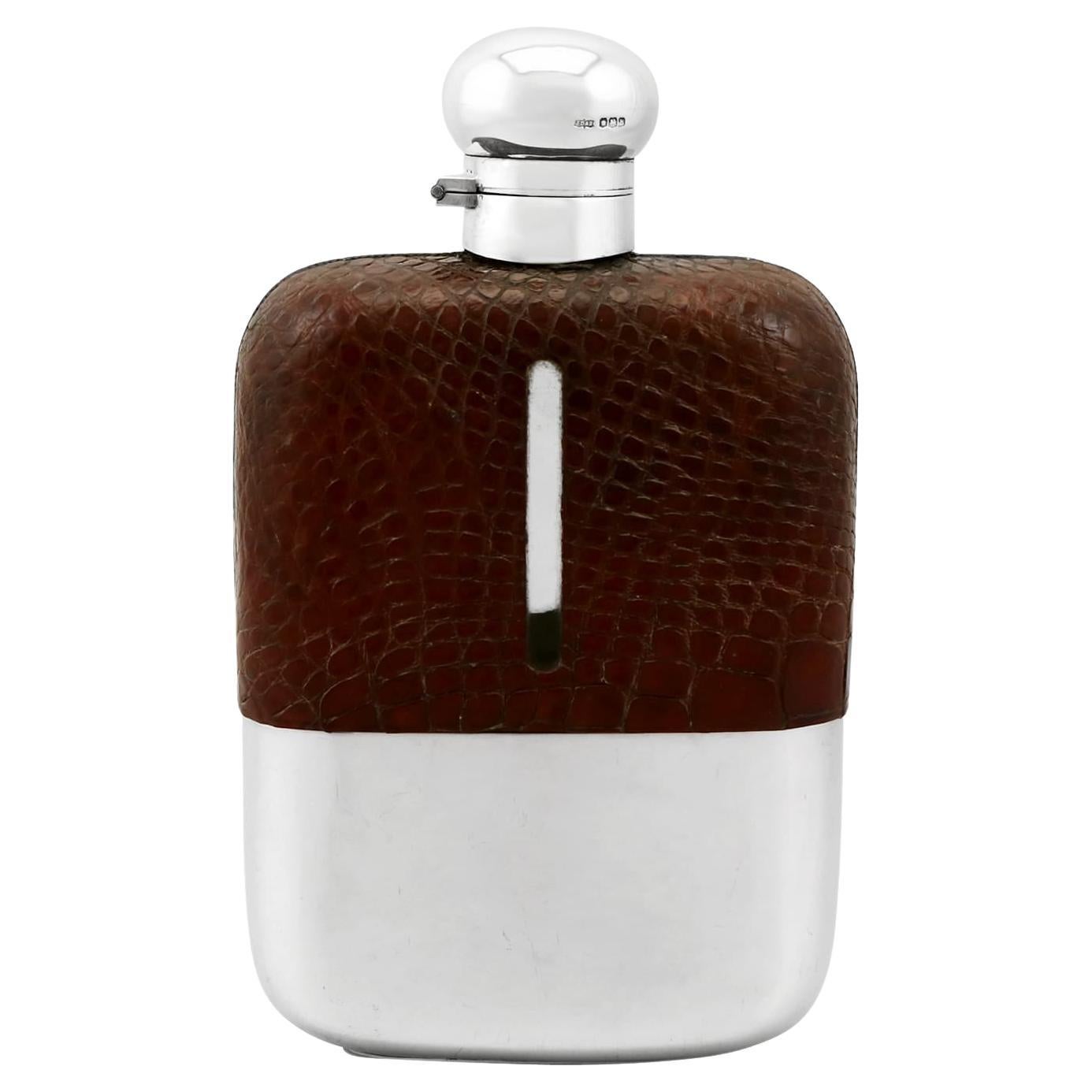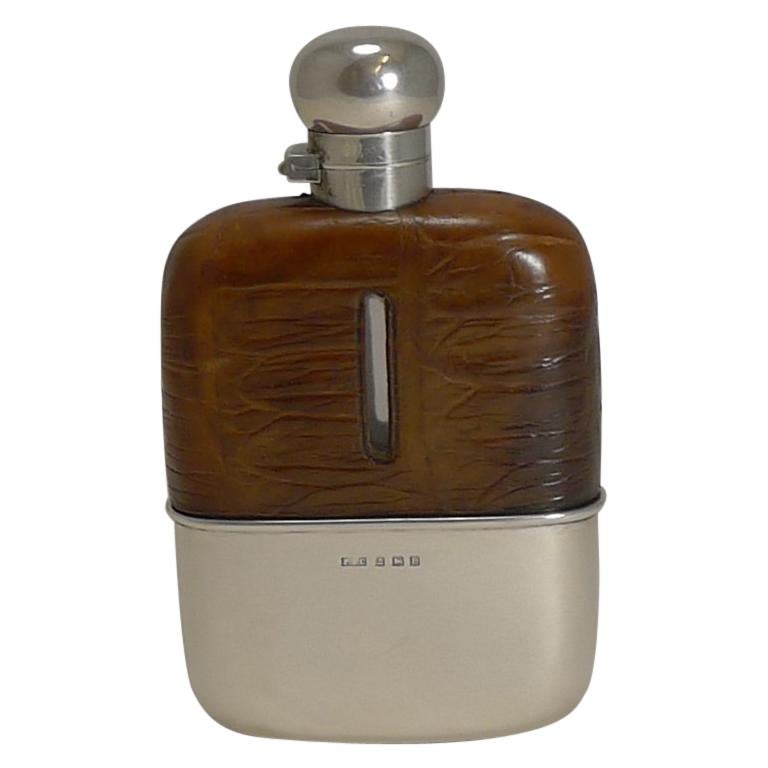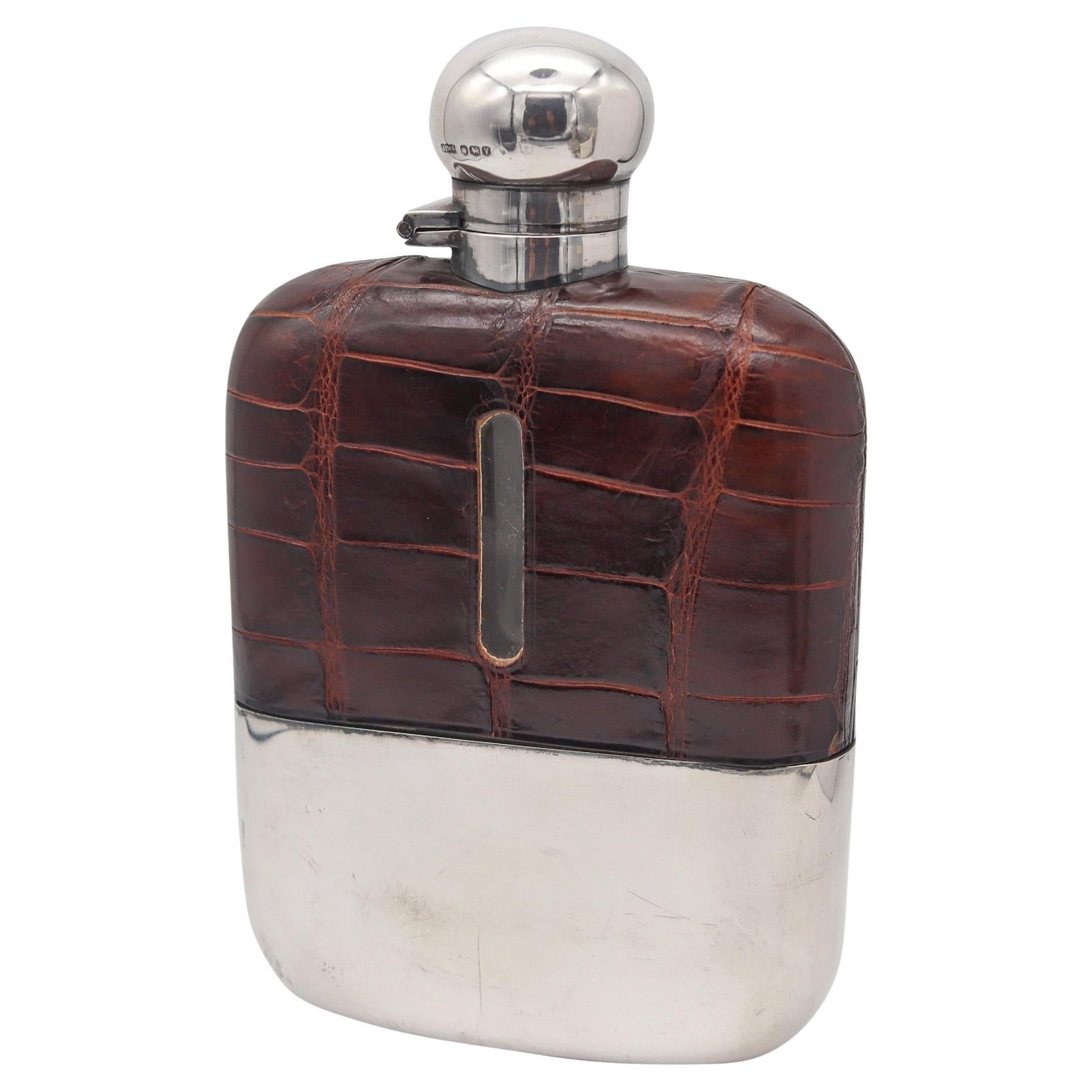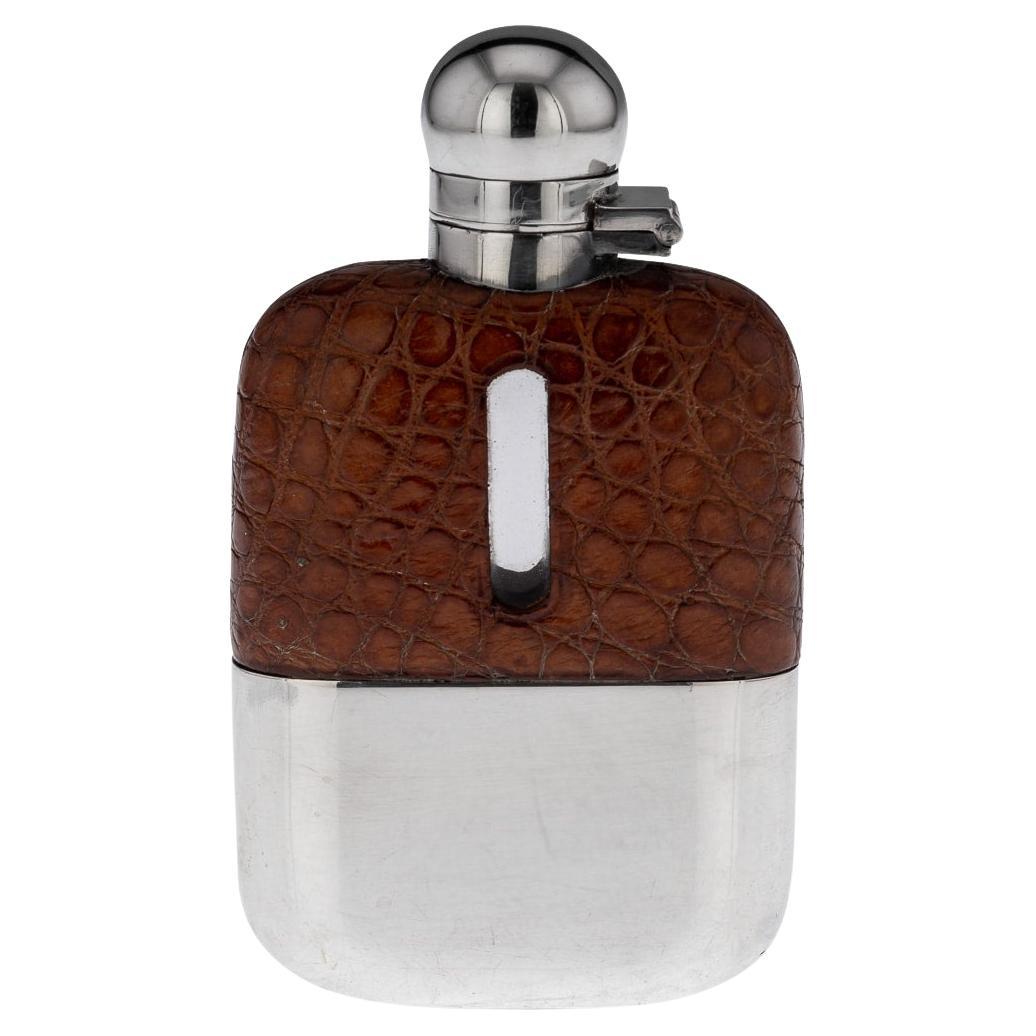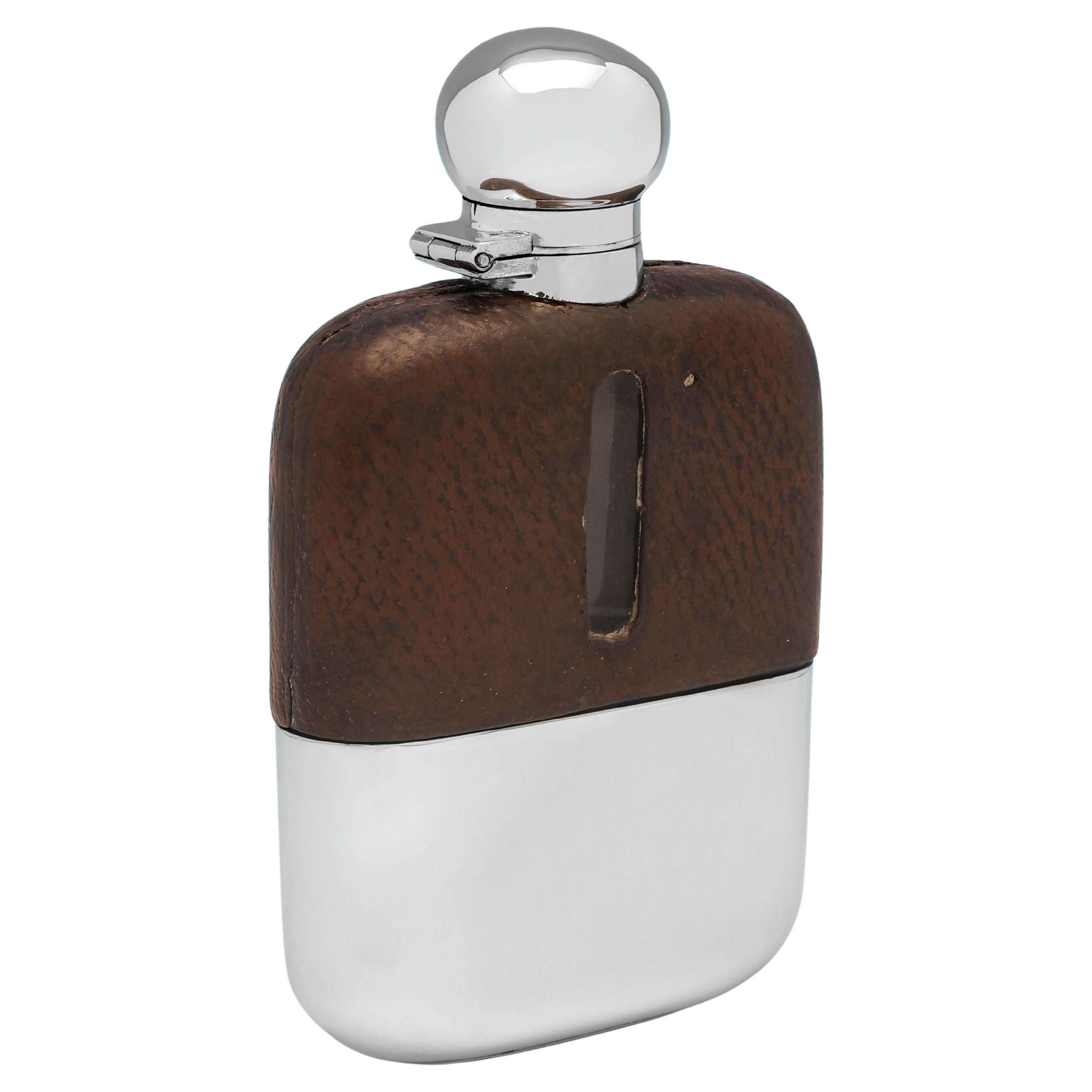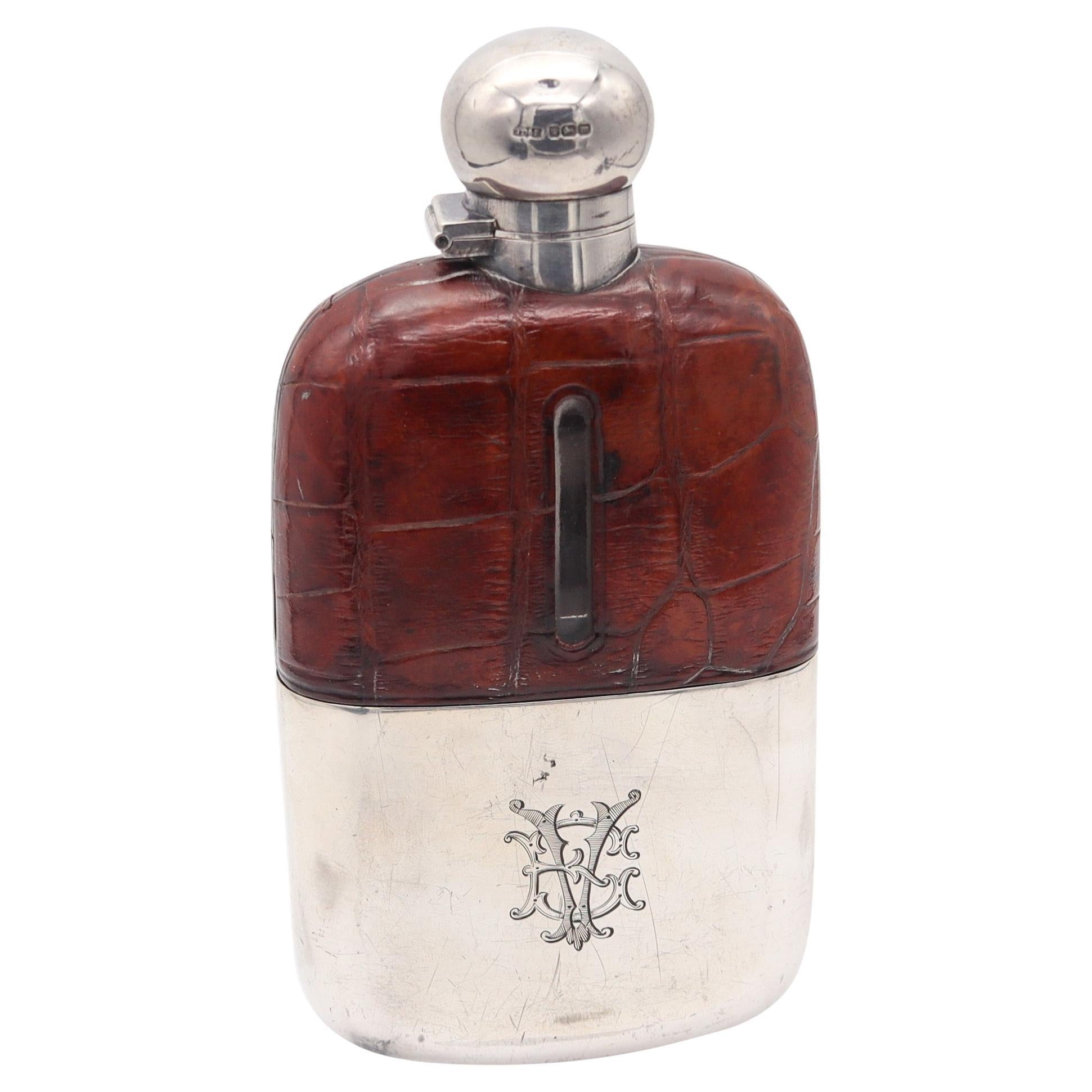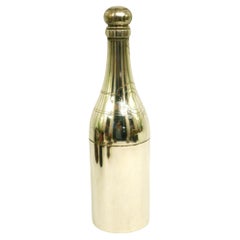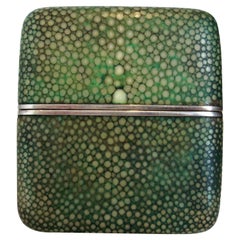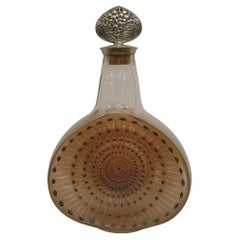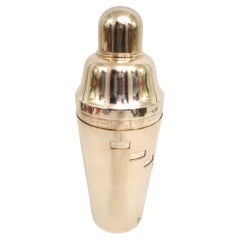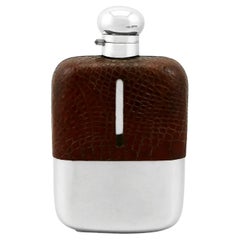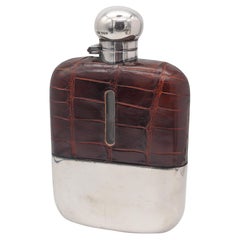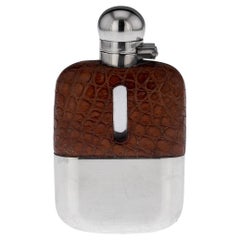Items Similar to Antique 1902 James Dixon & Son Sterling Silver / Leather Skin Hip Flask
Want more images or videos?
Request additional images or videos from the seller
1 of 12
Antique 1902 James Dixon & Son Sterling Silver / Leather Skin Hip Flask
$1,650
£1,269.29
€1,473.28
CA$2,326.89
A$2,606.51
CHF 1,369.03
MX$31,694.36
NOK 17,336.45
SEK 16,456.95
DKK 10,995.69
About the Item
A magnificent, fine and impressive, antique George V glass, English sterling silver and Lizard / Snake skin Leather mounted hip flask.
This magnificent antique George V sterling silver hip flask has a rectangular form with rounded corners.
The upper portion of the large glass body is ornamented with an impressive Lizard / Snake skin covering.
This impressive flask is fitted with a plain domed fully hallmarked hinged cover, securing with a bayonet fitting.
This Lizard / Snake Leather skin hip flask retains the original hallmarked push fit drinking cup.
Marked English Sterling Silver J.D & S into a shield, James Dixon & Sons, London 1902.
Business established in 1806 in Silver Street, Sheffield by James Dixon in partnership with a Mr. Smith. The firm became James Dixon & Son (1823), James Dixon & Sons (1835c.) and James Dixon & Sons Ltd in 1920. London showrooms were opened in London (1873), Sidney and Melborne (1912).
Such examples are becoming increasingly difficult to locate.
This antique hip flask has been tested for water tightness and is ready for use.
To ensure the flask remains water tight, the cork should be moist and therefore fully expanded to provide an effective seal.
There are two recommended methods to ensure that the cork does not dry out and shrink:
Method One: Keep fluid in the flask at all times, and keep the flask on its side to ensure the cork remains wet.
Method Two: Fill the flask to the brim with fluid and close. Leave it like this overnight, or for 24 hours if possible, before use.
We have specialized in the sale of Art Deco and Art Nouveau and Vintage styles since 1995. If you have any questions we are at your disposal. Pushing the button that reads 'View All From Seller'. And you can see more objects to the style for sale. Why are there so many antiques in Argentina?
In the 1880 – 1940 there was a grate wave of immigration encouraged by the periods of war that were taking place. 1st World War took place between 1914 and 1918 2nd World War took place between 1939 and 1945 The immigrants options were New York or Buenos Aires. Tickets were cheap and in Buenos Aires they were welcomed with open arms, as it was a country where everything was still to be done. Argentina was the country of new opportunities, labour was needed and religious freedom was assured, in many cases the of the family travel first until they were settled and then the rest of the family members join them. In the immigrant museum “Ellis Island Immigrant Building” in New York you can se the promotional posters of the boats that would take them to a new life. Between the years 1895 and 1896, Argentina had the highest DGP (gross domestic product) per capita in the world according to the Maddison Historical Statistics index, this situation arose due to the large amount of food being exported to European countries, which were at war. The Argentinean ships left the port of Buenos Aires with food, but they returned with furniture, clothes and construction elements, (it´s common to see this the old buildings of the historic neighbourhood of San Telmo, the beams with the inscription “Made in England)”, as well as many markets that were built in Buenos Aires, such us the San Telmo Market, whose structure was brought by ship and afterwards assembled in 900 Defensa Street. With the great influence of European immigrants living in the country, the children of the upper classes travelled to study in France, resulting in the inauguration of “La Maison Argentinienne”, on 27th of June 1928, in the international city of Paris, which hosted many Argentinians that were studying in Frace. It´s the fourth house to be built after France, Canada and Belgium, being the first Spanish-speaking one. Still in place today (17 Bd Jourdan, 75014, Paris, France). Many of the children of these wealthy families who attended international art exhibitions, museums and art courses abroad, took a keen interest in the European style. This is why Buenos Aires was at the time referred as “The Paris of South America”. Between the years 1890 and 1920 more than a hundred Palaces were built on Alvear Avenue the most exclusive avenue in Buenos Aires. Today some of these palaces have been transformed into museums, hotels and embassies. In the year 1936, the Kavanagh building was inaugurated, it was the tallest reinforced concrete building in South America. During 1994 the American Society of Civil Engineers distinguished it as an “international engineering milestone”, and it´s now considered a World Heritage of Modern Architecture. At the time was common to hire foreign architects such as Le Corbusier, who visited Buenos Aires/Argentina in 1929 and in 1948 he drew up the blueprints for a house built in La Plata City (which was declared a World Heritage Site). In 1947, the Hungarian architect Marcelo Breuer designed “Parador Ariston” in the seaside city of Mar del Plata. After an Argentinean student at Harvard University convinced him to come to Argentina. He worked on an urban development project in the Casa Amarilla, area of La Boca. The Ukrainian architect, Vladimiro Acosta, arrives in Argentina in 1928 and worked as an architect until que moved to Brazil. Antonio Bonet, a Spanish architect who worked with Le Corbusier in Paris, arrives in Argentina in 1937, where he carried out several architectural works and in 1938 designs the well-known BFK chair. Andres Kálnay, of Hungarian origin, made around 120 architectural masterpieces, among which the former Munich brewery stands out, he even made the furniture’s design. The German architect, Walter Gropius, director of the Bauhaus, lived in Argentina, where he wrote articles for “Sur” magazine and founded in Buenos Aires, an architectural firm with Franz Möller, who was also an architect, where he built two houses. At the same time several famous designers decided to immigrate to Argentina, among them we can find the well-known French designer, Jean-Michel Frank, who arrived in the country in 1940 and also worked for the Rockefeller family. Special pieces were made, which were sold exclusively in the country, such as the well-known German company “WMF”, who sold their products by catalogue, which were chosen by the ladies of high society in the list of wedding gifts, as well as the pieces designed by Christofle. The Swiss sculptor Alberto Giacometti, made special pieces for Argentinean mansions. In 1904 the first Jansen branch outside Paris was established in Buenos Aires, as the Argentinean clientele demanded a large amount of furniture, from the end of the 19th century to the mid-20th century. In 1970, the brand Rigolleau Argentina made pieces authorised by Lalique. The brands Maple and Thompson also set up shop in the country. The French plastic artist, Marcel Duchamp moved to Argentina in 1918-1919. Glass signed Gallé, Charder, Leverre, Schneider, Muller and other French firms. They were bought in flower shops and were given to ladies with beautiful floral arrangements. Some furniture manufacturers travelled to international fairs and bough the patterns to produce the furniture in Argentina, such as the furniture firm Englander and Bonta, who bought the patterns in Italy. It is worth mentioning that in Argentina we have the largest community of Italians outside of Italy, as it is estimated that 70 percent of the inhabitants have at least one Italian descendant, followed by Spanish immigrants. The most Important furniture stores in Argentina: Comte is founded in 1934 (under the direct management of Jean Michel Frank in 1940). Nordiska (Swedish company established in 1934). Churba in 1960, a company that brought foreign designers to present their furniture in the country: Denmark: (Arne Jacobsen, Finn Juhl, Bender Madsen, Ejner Larsen, Poul Kjaerholm, Hans Wegner) Sweden: (Hans Agne Jakobsson, Gustavsberg) United States: (Herman Miller) Finland: (Lisa Johansson, Folke Arstrom, Tapio Wirkkala, Alvar Aalto, Timo Sarpaneva) Swedish Factory: (Orrefors) Italy: (Littala, Vico Magistretti, Emma Gismondi, Gae Aulenti, Angelo Mangiarotti, Elio Martinelli, Gianna Celada, Angelo Mangiarotti, Mario Bellini, Carlo Scarpa) Finland: (Olivia Toikka) Plata Lappas (Lappas Silver): a goldsmith shop founded in 1887 in Argentina by Alcibiades Lappas of Greek origin. In 2019, in Argentina took place “the Art Deco world congress” . Argentina currently has more than 100 Art Deco buildings and another 90 Art Nouveau buildings throughout the city of Buenos Aires. Argentina is a country that has not been involved in many wars, which is why it has been a refuge for works of art and antiques from different periods of time, unlike European countries. That is way many collectors, museums and antique dealers from all over the world visit it, you should not miss the opportunity to visit this great country.
- Creator:James Dixon & Sons (Jeweler)
- Dimensions:Height: 6.3 in (16 cm)Width: 3.94 in (10 cm)Depth: 1.19 in (3 cm)
- Style:Art Nouveau (Of the Period)
- Materials and Techniques:
- Place of Origin:
- Period:
- Date of Manufacture:1902
- Condition:Additions or alterations made to the original: Cork has been changed for a new one, so it can be used. The original cork had 120 years, wasn´t in the best conditions. Wear consistent with age and use.
- Seller Location:Buenos Aires, AR
- Reference Number:1stDibs: LU2027331702252
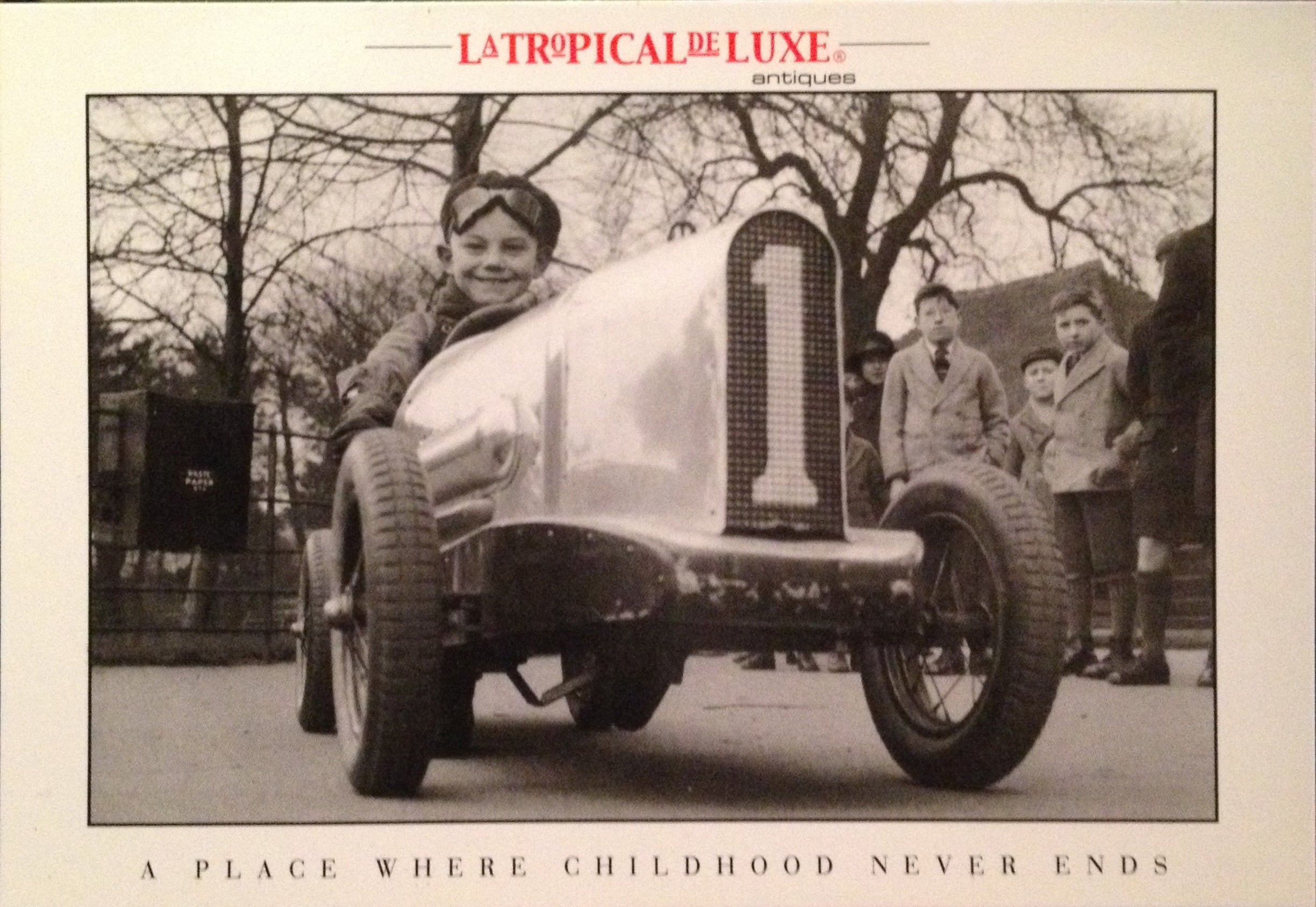
About the Seller
4.9
Vetted Professional Seller
Every seller passes strict standards for authenticity and reliability
Established in 2002
1stDibs seller since 2016
320 sales on 1stDibs
Typical response time: 1 hour
- ShippingRetrieving quote...Shipping from: Buenos Aires, Argentina
- Return Policy
Authenticity Guarantee
In the unlikely event there’s an issue with an item’s authenticity, contact us within 1 year for a full refund. DetailsMoney-Back Guarantee
If your item is not as described, is damaged in transit, or does not arrive, contact us within 7 days for a full refund. Details24-Hour Cancellation
You have a 24-hour grace period in which to reconsider your purchase, with no questions asked.Vetted Professional Sellers
Our world-class sellers must adhere to strict standards for service and quality, maintaining the integrity of our listings.Price-Match Guarantee
If you find that a seller listed the same item for a lower price elsewhere, we’ll match it.Trusted Global Delivery
Our best-in-class carrier network provides specialized shipping options worldwide, including custom delivery.More From This Seller
View AllArt Deco Rare Silvered Champagne Bottle Cocktail Shaker. France 1930´s
Located in Buenos Aires, Olivos
Art Deco Rare Silvered Champagne Bottle Cocktail Shaker. France 1930´s.
A rare silver plated Champagne bottle cocktail shaker with en...
Category
Mid-20th Century French Mid-Century Modern Barware
Materials
Metal
Art Deco Leather and Sterling Silver Cigarette / Cigar Case
Located in Buenos Aires, Olivos
Exquisite leather cigar case with sterling silver collar. Expands for differing lengths of small cigar or cigarettes.
Made in the U.K. in the 1900-1920´s. It has the stamp of the re...
Category
Early 20th Century British Art Deco Tobacco Accessories
Materials
Sterling Silver
$1,200 Sale Price
20% Off
1913 René Lalique Decanter Reine Marguerite Glass with Brown Enamel Sepia Patina
By René Lalique
Located in Buenos Aires, Olivos
Art Deco Rene Lalique Decanter "Reine Marguerite" made in clear and frosted glass with sepia patina and original brown heated enamel created by René Lalique in 1913.
Original metal s...
Category
Early 20th Century French Art Deco Pitchers
Materials
Art Glass
$4,900 Sale Price
30% Off
Art Deco Napier Recipe / Menu Cocktail Shaker, c.1930's
By Napier Co.
Located in Buenos Aires, Olivos
20th century Art Deco "Dial a Drink" recipe menu cocktail shaker silver plate circa 1930.
A wonderful mechanism wraps around the shaker and works...
Category
Mid-20th Century British Mid-Century Modern Barware
Materials
Brass
Art Nouveau Sterling Silver Flower Vase, William Hutton & Sons, c. 1903
By William Hutton & Sons
Located in Buenos Aires, Olivos
William Hutton & Sons. London, Birmingham & Sheffield. circa 1903.
An exceptional Art Nouveau silver and vase by William Hutton dated 1...
Category
Early 20th Century British Art Nouveau Sterling Silver
Materials
Sterling Silver
Christofle Art Deco Design Champagne, Wine Cooler, France, 1980s
By Christofle
Located in Buenos Aires, Olivos
Christofle Art Deco design champagne, wine cooler, France, 1980s. Very chic!
The candleholders on the pictures are not included, will be sold separate.
We have specialized in the sa...
Category
Vintage 1980s French Art Deco Wine Coolers
Materials
Metal
You May Also Like
1920s Sterling Silver and Crocodile Skin Hip Flask
By James Dixon & Sons
Located in Jesmond, Newcastle Upon Tyne
A magnificent, fine and impressive, large antique George V glass, English sterling silver and crocodile skin mounted hip flask; an addition to our silver mounted glass collection.
...
Category
Vintage 1920s British Barware
Materials
Sterling Silver
English Sterling Silver and Crocodile Skin Hip Flask, 1929
Located in Bath, GB
A handsome English sterling silver hip or liquor flask made from sterling silver and the upper half wrapped in Crocodile skin with a lovely cognac color with a good patina.
The co...
Category
Vintage 1920s English Art Deco Barware
JAMES DIXON & SONS 1891 Sheffield Large Liquor Flask In .925 Sterling & Leather
By James Dixon & Sons
Located in Miami, FL
Liquor flask bottle designed by James Dixon & Sons.
Very handsome and handy antique liquor flask bottle, created in Sheffield England at the silversmith workshop of James Dixon & So...
Category
Antique 1890s English Edwardian Sterling Silver
Materials
Silver, Sterling Silver
20th Century English Solid Silver & Leather Hip Flask, Sheffield, c.1939
By James Deakin & Sons
Located in Royal Tunbridge Wells, Kent
A superb 20th Century solid silver, blown glass and bound in sumptuous crocodile leather hip flask, of rounded rectangular form, with a pull off cup, top mounted with a large hinged ...
Category
20th Century British Barware
Materials
Silver
Art deco period crocodile skin and sterling silver hip flask made in 1932
By James Dixon & Sons
Located in London, London
Hallmarked in Sheffield in 1932 by James Dixon & Sons, this stylish, George V, Sterling Silver Hip Flask, features a glass body with a crocodile skin cover, and a silver removable cu...
Category
Vintage 1930s English Art Deco Barware
Materials
Sterling Silver
JAMES DIXON & SONS 1904 Sheffield Large Liquor Flask In .925 Sterling &
By James Dixon & Sons
Located in Miami, FL
Liquor flask bottle designed by James Dixon & Sons.
Very handsome and handy liquor flask bottle, created in Sheffield England by the silversmith James Dixon & Sons, back in the 1904...
Category
Vintage 1970s English Edwardian Sterling Silver
Materials
Silver, Sterling Silver
More Ways To Browse
International Silver 1939
Sterling Silver Spain
Silver Lizard
Leather Shield
Frank And Son Furniture
Seal Skin
Sterling Watering Can
Sterling Silver Watering Can
Sterling Flask
Original Bauhaus Poster
Dixon And Sons
Silver Food Cover
Sheffield Silver Cup
Snake Art Nouveau
Antique Sterling Silver Flask
Swedish Drinking Glasses
Frank And Sons Chair
Johansson Soner
